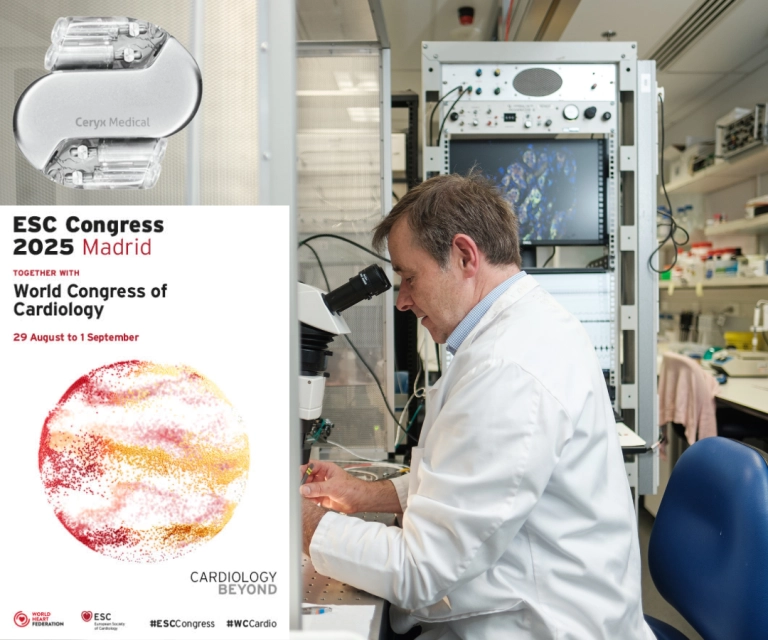Breathing Life into the Heart: Professor Julian Paton’s “Natural Pacemaker” Takes Centre Stage in Madrid
Professor Julian Paton, Director of Manaaki Manawa—the Centre for Heart Research at the University of Auckland and Co-Director of Pūtahi Manawa Healthy Hearts for Aotearoa NZ - Centre of Research Excellence - has championed a transformative journey in pacemaker technology, turning groundbreaking laboratory discoveries into patient-focused therapies.
The latest instalment in this research, carried out in close collaboration with colleagues Dr Julia Shanks, Associate Professor Rohit Ramchandra, Dr Mridula Pachen, Associate Professor Nigel Lever and Professor Martin Stiles from the University of Auckland, will be in the global spotlight—with a presentation slated for the upcoming joint European Society of Cardiology (ESC) Congress 2025 and the World Congress of Cardiology in Madrid this 29 August–1 September.
At the University of Auckland, Paton and his team have reimagined how pacemakers support the heart. Traditional devices deliver a steady, metronomic beat – that is, the pace doesn’t change. In contrast, their “natural” or “bionic” pacemaker restores respiratory-linked variability - speeding up when breathing in, and slowing down when breathing out - bringing back a natural heart rhythm often lost in those with cardiovascular disease.
“People with high blood pressure, people with heart failure, their heart rate is not being modulated by their breathing. It may be a little bit, but it’s very, very depressed, very suppressed,” Paton says. “We decided that we would put the heart rate variability back into animals with heart failure and see if it did anything good.”
In animal models, this approach delivered remarkable outcomes: up to a 20% boost in cardiac output, improved exertional capacity, and faster post-exercise recovery—benefits unseen with conventional pacing. Reflecting on these results, Dr Julia Shanks called it a return to nature’s own design, while Professor Ramchandra emphasised the potential for this device to revolutionise care for heart failure patients.
With first-in-human trials already underway in Waikato—and now extending to Adelaide, Melbourne, Bristol, and Cardiff—the project has passed the critical boundary from lab to live trials, thanks in part to leadership from Martin Stiles and support from Ceryx Medical and the Health Research Council of New Zealand.
The Manaaki Manawa and Pūtahi Manawa connection
Paton’s leadership at Manaaki Manawa connects deeply with Pūtahi Manawa’s mission to elevate heart health through innovation and indigenous and community–centred research pathways. Professor Paton first established the faculty research centre, Manaaki Manawa, at the University of Auckland’s Faculty of Medical and Health Sciences. From there, he brought research scientists, clinicians, and educators together with communities across Aotearoa to successfully bid for a national Centre of Research Excellence - Pūtahi Manawa | Healthy Hearts for Aotearoa NZ.
His distinguished career—including election as a Fellow of the Royal Society Te Apārangi, more than 430 publications, and global research translation—embodies the kind of world-class science Pūtahi Manawa celebrates.
Spotlight in Madrid
From 29 August to 1 September 2025, ESC Congress 2025—hosted together with the World Congress of Cardiology in Madrid—will bring the world’s cardiology community under one roof. With a theme of “Cardiology Beyond Borders” and a broader focus on global health, the event promises cutting-edge science, innovation and cross-border exchange to transform patient care worldwide.
Professor Paton’s upcoming presentation there marks a milestone: showcasing New Zealand-bred technology on a world stage, framed by Pūtahi Manawa’s ambition to shift the global narrative on heart therapy. Attendees will have the opportunity to engage directly with his insights on how re-introducing heart-rate variability could rewrite the future of pacemaker therapy.
Read more about the new pacemaker



